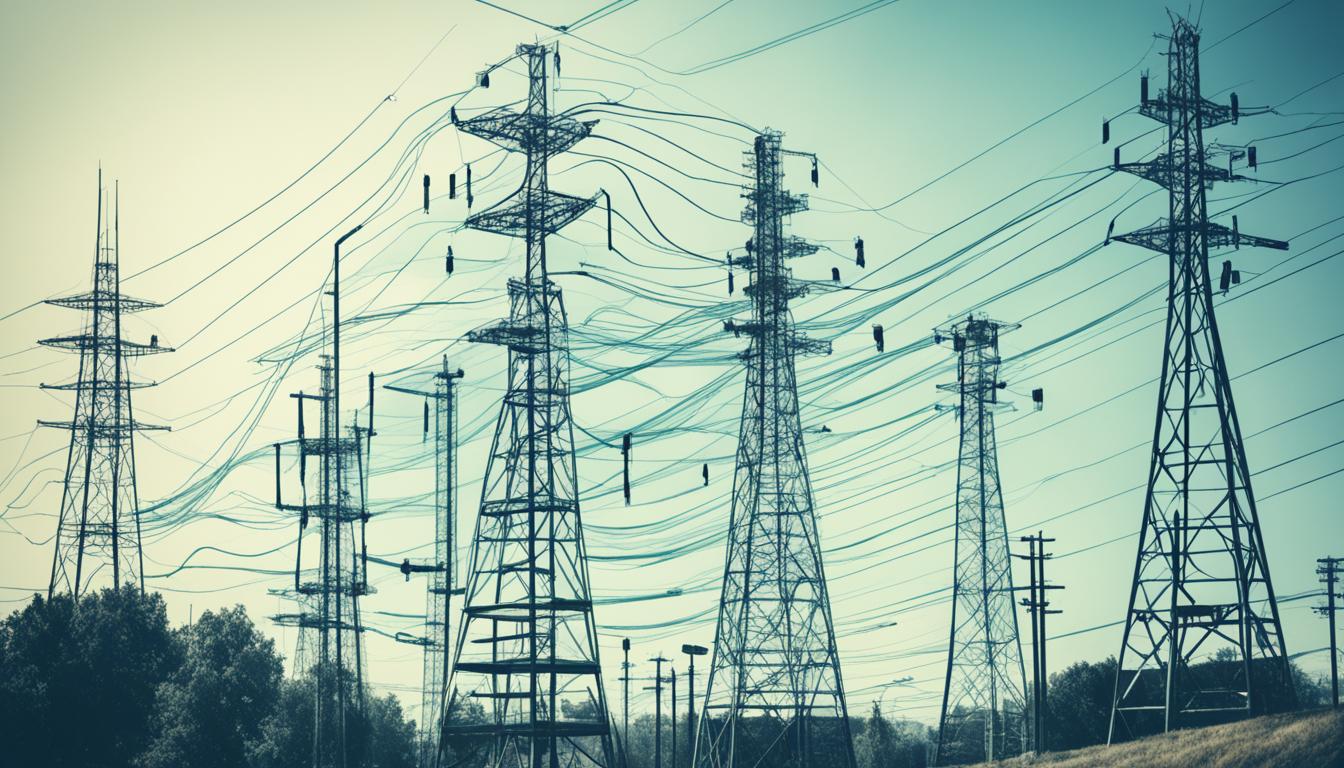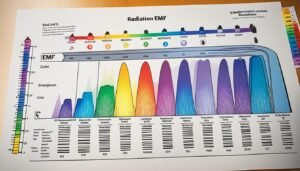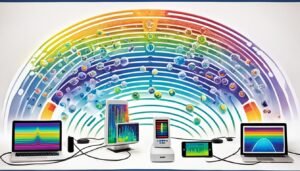Disclosure: This Post Contains Affiliate Links; We earn a commission on purchases.
When it comes to electromagnetic fields (EMFs), there are two distinct categories: ionizing and non-ionizing. Understanding the difference between these two types of radiation is crucial for assessing potential health risks and ensuring EMF safety.
Ionizing radiation refers to high-level radiation with enough energy to remove tightly bound electrons from atoms or molecules, resulting in cellular and DNA damage. On the other hand, non-ionizing radiation is low-level radiation that is generally considered harmless and does not have enough energy to ionize atoms or cause cellular damage.
Examples of non-ionizing EMFs include extremely low frequency (ELF) fields, radiofrequency (RF) radiation, microwaves, and visual light, while ionizing EMFs include ultraviolet (UV) radiation, X-rays, and gamma rays.
Key Takeaways:
- EMFs can be classified into ionizing and non-ionizing radiation.
- Ionizing radiation has the potential to cause cellular and DNA damage.
- Non-ionizing radiation is generally considered harmless.
- Non-ionizing EMFs include ELF fields, RF radiation, microwaves, and visual light.
- Ionizing EMFs include UV radiation, X-rays, and gamma rays.
Understanding Electric and Magnetic Fields
Electric and magnetic fields are invisible areas of energy, also known as radiation, that are produced by electricity. An electric field is created by voltage, which is the pressure used to push electrons through a wire, while a magnetic field is generated by the flow of current through wires or electrical devices.
Electric fields are measured in volts per meter (V/m) and magnetic fields are measured in microteslas (μT). These fields are collectively called electromagnetic fields (EMFs). EMFs can be categorized into non-ionizing and ionizing radiation.
Non-ionizing radiation includes low- to mid-frequency radiation that is not known to damage DNA or cells directly. On the other hand, ionizing radiation includes high-frequency radiation that can potentially cause cellular and DNA damage.
Non-ionizing EMFs are commonly generated by everyday devices and technologies such as power lines, appliances, Wi-Fi routers, and cell phones. While these fields are generally considered safe, there is ongoing research to better understand their long-term effects on human health.
“Electric and magnetic fields are essential to our modern way of life, powering a wide range of devices and technologies. Understanding the different types of radiation they generate is crucial for ensuring the safe use of these technologies.”
By contrast, ionizing radiation is typically associated with sources such as X-rays, gamma rays, and certain nuclear materials. This type of radiation has much higher energy levels, which can cause damage to cells and DNA, leading to potential health risks.
To protect ourselves from the potential health risks associated with EMFs, it is important to maintain a balanced approach. While non-ionizing radiation is generally considered safe, it is still advisable to limit exposure and follow safety guidelines to minimize any potential risks.
Key Takeaways:
- Electric and magnetic fields are forms of radiation produced by electricity.
- Electric fields are created by voltage, while magnetic fields are generated by the flow of current.
- EMFs can be categorized into non-ionizing radiation (low- to mid-frequency) and ionizing radiation (high-frequency).
- Non-ionizing radiation is not known to damage DNA or cells directly, while ionizing radiation has the potential for cellular and DNA damage.
- It is important to follow safety guidelines and limit exposure to minimize potential health risks associated with EMFs.
Sources of Non-Ionizing EMFs
Non-ionizing electromagnetic fields (EMFs) can originate from both natural and human-made sources. While natural sources include the Earth’s magnetic field, human-made sources contribute significantly to our exposure to non-ionizing EMFs. Some common sources of non-ionizing EMFs include:
- Extremely Low Frequency (ELF) EMFs from power lines, electrical wiring, and household appliances.
- Radiofrequency radiation emitted by wireless telecommunication devices such as cell phones, Wi-Fi networks, and smart meters.
- Radio and television signals.
- Radar and satellite stations.
- Microwave ovens.
- Cordless telephones.
- Other household appliances and devices that require electricity.
It’s important to note that the strength of these non-ionizing EMFs decreases as you move further away from the source. For example, when using a cell phone, the intensity of the radiofrequency radiation decreases significantly as you increase the distance between your body and the device.
Health Risks and Studies
The potential health risks of EMF exposure, especially in relation to cancer, have been extensively studied. While there is no identified mechanism by which non-ionizing EMFs directly cause cancer, some scientists propose that ELF-EMFs may impact tumor development by reducing melatonin levels.
“ELF-EMFs might affect tumor development by reducing levels of melatonin.”
However, studies conducted on animals have not found evidence supporting a link between ELF-EMFs and cancer.
When it comes to radiofrequency and microwaves, intense exposure to these forms of non-ionizing radiation can cause tissue damage due to heat. It is essential to exercise caution and limit excessive exposure to these types of radiation.
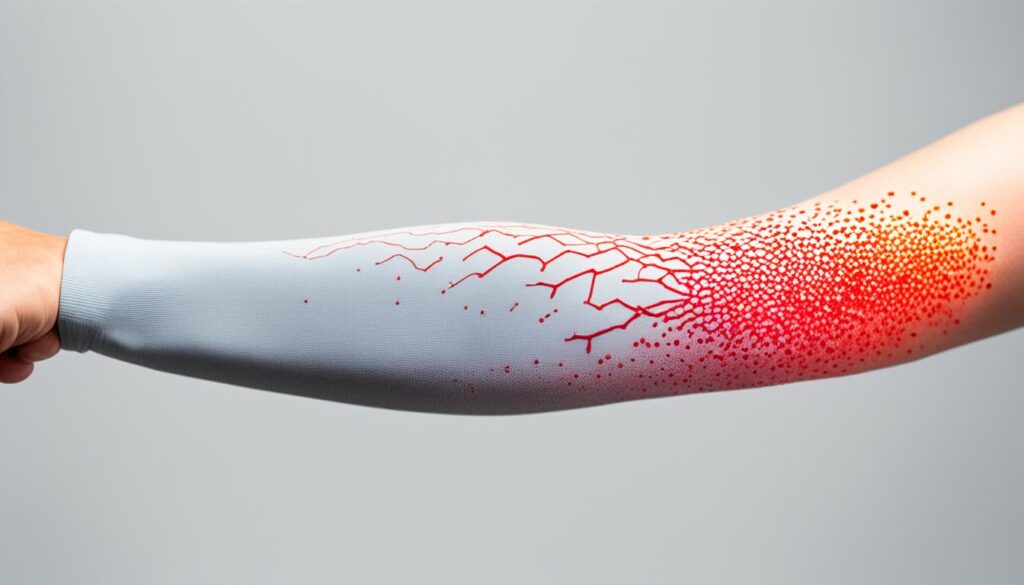
UV radiation, another form of non-ionizing radiation, poses risks such as skin burns, premature aging, eye damage, and skin cancer.
“UV radiation can lead to skin burns, premature aging, eye damage, and skin cancer.”
To ensure health and well-being, it is crucial to exercise caution when exposed to EMFs and limit excessive exposure to non-ionizing radiation, particularly ELF-EMFs, radiofrequency radiation, and UV radiation.
EMF Safety and Protection
To ensure your safety from EMF exposure, it is crucial to adhere to established safety standards and guidelines. By following these measures, you can reduce your exposure and minimize any potential risks. Here are some important practices to consider:
Maintain Distance from EMF Sources
One effective way to reduce your exposure to EMFs is by maintaining a safe distance from their sources. The strength of electromagnetic fields decreases as you move away from the source. For example, if you are using a microwave oven or a Wi-Fi router, try to keep a distance from these devices to minimize your exposure.
Utilize Shielding Methods
Shielding can be an effective method in reducing your exposure to EMFs. It involves using materials that can block or absorb electromagnetic radiation. For instance, you can use EMF shielding paints, fabrics, or films to create barriers between yourself and the source of EMFs, such as power lines or electrical appliances.
Safe Use of Devices
When using devices that emit EMFs, such as cell phones or Wi-Fi routers, it is important to practice safe usage. For example, you can use hands-free options or speakerphones when making calls to reduce your exposure. Additionally, keeping devices away from your body, such as placing your cell phone on a table instead of in your pocket, can also help minimize EMF exposure.
Practice Sun Protection
In addition to EMFs, it is essential to protect yourself from excessive UV radiation, which can have harmful effects on your skin. Here are some sun protection measures to consider:
- Wear sunscreen with a high SPF to shield your skin from the sun’s harmful rays.
- Cover up with protective clothing, such as wide-brimmed hats and long-sleeved shirts.
- Wear sunglasses with UV protection to safeguard your eyes from the sun’s radiation.
By following these safety measures, both in terms of EMF exposure and UV radiation, you can take proactive steps to protect your health and well-being.
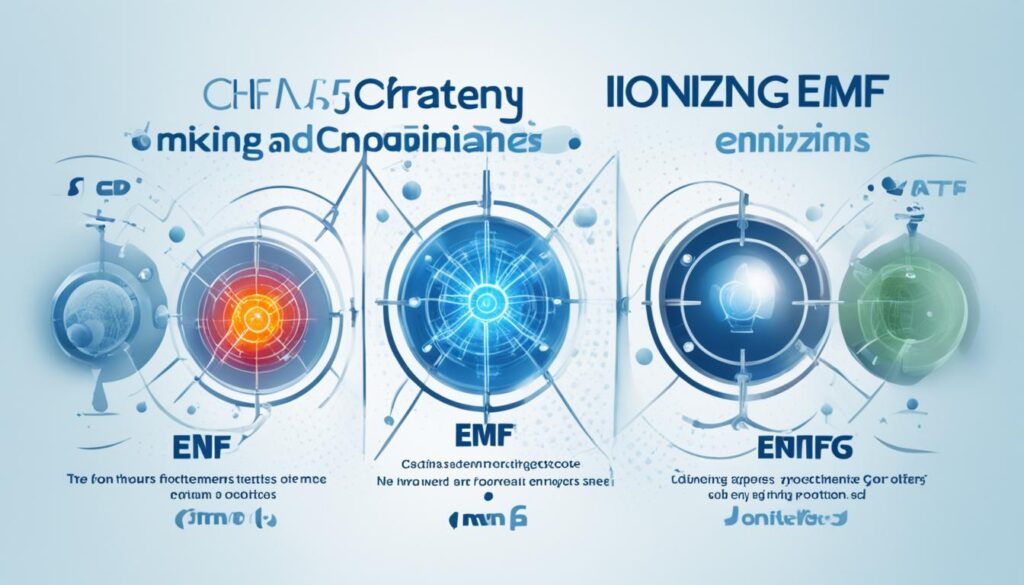
| Safe Practices | Benefits |
|---|---|
| Maintaining distance from EMF sources | Reduces EMF exposure and potential health risks |
| Utilizing shielding methods | Reduces direct exposure to EMFs |
| Practicing safe use of devices | Minimizes EMF exposure from personal electronic devices |
| Practicing sun protection | Minimizes the risk of skin damage and cancer from excessive UV radiation |
Conclusion
In conclusion, the classification of electromagnetic fields (EMFs) into ionizing and non-ionizing radiation is based on their frequency. Ionizing radiation, with its high-level energy, carries the potential for cellular and DNA damage. On the other hand, non-ionizing radiation is generally considered harmless and includes electromagnetic fields such as extremely low frequency (ELF), radio frequency (RF), and microwaves.
While ongoing research is being conducted to understand the health effects of EMF exposure, current evidence suggests that there is no strong link between non-ionizing EMFs and cancer in adults. However, it is crucial to prioritize safety and take necessary precautions to minimize potential risks. Following established EMF safety standards, reducing exposure, maintaining a safe distance from EMF sources, and practicing safe use of devices are recommended measures.
Additionally, it is important to safeguard against excessive exposure to ultraviolet (UV) radiation, another form of non-ionizing radiation. By adopting sun protection measures, such as using sunscreen and wearing protective clothing, we can reduce the risk of skin damage and cancer associated with UV radiation.
Source Links
- https://www.cancer.gov/about-cancer/causes-prevention/risk/radiation/electromagnetic-fields-fact-sheet
- https://www.niehs.nih.gov/health/topics/agents/emf
- https://www.cdc.gov/nceh/radiation/nonionizing_radiation.html

Subscribe to Our Newsletter







